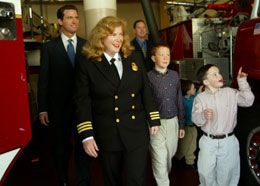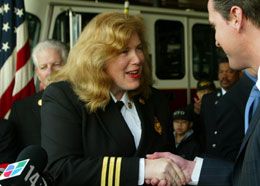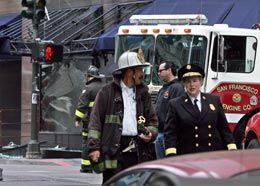| Editor’s note: This is the first of a series of FireRescue1 interviews with prominent fire chiefs from across the nation designed to shed light on the different issues they face and approaches they take to protecting the community. |
By MATT KAPKO
FireRescue1 News Editor
While many of the headlines coming out of San Francisco often get the dismissive tagline “only in San Francisco,” it couldn’t ring more true for the woman in charge of the city’s fire department, Joanne Hayes-White. In commanding the SFFD — the largest urban fire department in the world with a female chief at its helm — Hayes-White has overcome everything from controversies surrounding firefighter alcohol use on the job to brownouts at firehouses and standardizing San Francisco’s fire hydrants, making them compatible with other fire departments’ vehicles throughout the region. She has pursued each challenge with one eye on innovation and the other on accountability to the city’s residents.
In this exclusive interview, Hayes-White reflects on past challenges and looks toward the future — such as preparing for the “big one.”
 Joanne Hayes-White, foreground left, walks toward a news conference where San Francisco Mayor Gavin Newsom, background left, announced Hayes-White as the new chief of the San Francisco Fire Department back in 2004.She was the first female fire chief in SFFD history. From right are Hayes-Whites’ sons, Logan White, Sean White, partially obscured center, Riley White and her husband Sean White. (AP Photo/George Nikitin) |
Unique chief for a unique department
Many refer to SFFD as an “East Coast fire department on the West Coast.” Rich in tradition and history, the department boasts one of the most diverse workforces in the country, she said. More than 14 percent of the department’s members are women, and many members speak Spanish and Cantonese.
Growing up, Hayes-White was always fascinated by the red fire engines, but never saw the fire service as a viable career option because there were no role models that looked like her, she said. Despite all that uncertainty, she couldn’t imagine doing anything else.
Hayes-White was born and raised in San Francisco. She was hired as a firefighter with the department in 1990 after graduating from the University of Santa Clara with a degree in business. She was later promoted to lieutenant in 1993 and captain in 1996.
Months after her promotion to captain, she was made acting battalion chief with oversight of the department’s dispatch and communications systems. She later unified dispatch communications in 1998 under the Emergency Communications Department, which brought fire, EMS and police dispatch communications under one roof, improving response times and interagency collaboration. Hayes-White was promoted to assistant deputy chief in 1998 and finally promoted to assistant deputy chief and director of training before getting the nod to be chief of the department.
According to Hayes-White, when San Francisco Mayor Gavin Newsom nominated her to the post more than two years ago, the mother of three boys — ages 12, 9 and 6 — wasn’t even pursuing the position. Now just 42 years old, she really only considered herself midway through her career when Newsom tapped her for the position, she said
 Hayes-White shakes hands with San Francisco Mayor Gavin Newsom, right, after Newsom named Hayes-White as the new chief of the SFFD back in 2004. (AP Photo/George Nikitin) |
“It is quite unique to have a woman as a chief,” she said. “It’s sort of a novel, bold decision by the mayor.”
Despite all the talk of gender, no one would argue that Hayes-White didn’t earn the job on her own merits. She describes herself as a “fair, firm and friendly” people person with a hands-on leadership style. While she recognizes she can’t please everyone, she aims to be as “open door” as she can. She would never ask someone to do something she isn’t willing to do (or can’t do) herself. “I’ve reopened the lines of communication,” she said, having worked at 41 of the city’s 42 stations and knowing 1,400 of the members by first name. “It still remains one of the most rewarding, yet most dangerous professions,” she said.
Training, preparedness
FireRescue1 sat down with Hayes-White at her office at department headquarters just one week after the city commemorated the 100-year anniversary of the 1906 earthquake and subsequent fire that destroyed much of San Francisco. With the disaster still fresh on her mind, Hayes-White said the department needs to “continue to be vigilant in preparing our community.”
San Francisco faces myriad potential disasters, but nothing strikes fear in the hearts of San Franciscans as much as the looming “Big One.” Despite these concerns, Hayes-White believes her firefighters are top notch and as prepared as possible for whatever Mother Nature or terrorists bring.
“We have a bit of a more educated workforce,” she said, noting that each member receives 30 to 40 hours of formal training a year. With 350 of the department’s 1,800 members on duty any time of the day, she requires at least one drill at each firehouse daily. Beyond that, battalion-based training sessions take place 10 to 12 times a year on a variety of topics, from ventilation to simulation.
“We’re blending our classrooms to have our police officers and firefighters training together,” she said. The department also coordinates citywide exercises alongside officers, EMTs and other first responders. Every member has completed a four-hour weapons of mass destruction course and the department has also beefed up training for radiological and biohazard response. “If it’s not a methodical effort it actually exacerbates the situation,” she said.
 Hayes-White, lower right, investigates the scene of an explosion back in 2005. (AP Photo/Ben Margot) |
Budget cuts, political realities
Hayes-White doesn’t hesitate when asked what her No. 1 challenge is: money. She’s seen public safety increasingly compete for revenue over the last six to eight years, mostly because of the growing number of competing interests, she said. “They’re being unfairly lumped into other things.” While Hayes-White calls Newsom a “very supportive boss,” she readily admits how challenging it has been dealing with administrative and political realities.
“With the shrinking economy, there are not enough dollars,” she said. “It’s been challenging to continue to provide the same level of service.” While she remains hopeful, she doesn’t foresee a windfall of cash anytime soon; in fact, she expects it to get worse.
Hayes-White said she feels she has made the most of the department’s budget, however limiting it may be. With 89 percent of the budget going to salaries, it’s plainly obvious that Hayes-White doesn’t have much wiggle room. “I’ve had to make some tough decisions and I think I’ve explained reasons for making them,” she said.
Brownouts
Not all of Hayes-White’s moves have been well-received. The brownouts, of which she considers herself the architect, have been wildly unpopular among the firefighters union and vocal residents, but it’s a decision Hayes-White said she had to make to absorb massive budget cuts beyond her control. The budget-reducing program took fire trucks and engines out of service at up to four stations a day. There are 42 stations citywide.
The community’s reactions ranged from hysteria over worst-case scenarios to acknowledgment of financial realities. Lt. John Hanley, president of San Francisco Firefighters Union Local 798, argued that up to six neighborhoods were left unprotected at any time as a result of the brownouts. Yet others reasoned that since San Francisco has more firehouses per square mile than any comparable city, the brownouts did not hamper the department’s emergency response capabilities.
To Hanley’s credit, the union successfully argued that “a minute is a lifetime” and collected more than 25,000 signatures for a ballot measure. After aggressive campaigning by the firefighters, Proposition F was passed in November 2005. The voter-approved measure required San Francisco to maintain service levels that existed on January 1, 2004 — before budget cuts led to the brownouts.
Hydrants standardization
Last year, when news broke that San Francisco was the only city in the state exempted from a law that required California’s fire departments to standardize their hydrants and hoses following the 1991 Oakland hills fire, Newsom began receiving political pressure from all sides demanding prompt action. Hayes-White quickly argued that the department couldn’t afford the approximately $800,000 it would cost to retrofit the city’s 7,900 low-pressure hydrants dispersed throughout its labyrinth of hills and narrow streets. Instead, she made contingency plans for a mutual aid situation. Outside fire departments will now be handed adapters that would narrow the 3-inch hose connections on city hydrants to fit the standard 2 1/2-inch hose. The cost? Approximately $50,000 to $75,000.
Alcohol use on job
One of the most visible controversies to hit the department in years came in late September 2005, when some of San Francisco’s firefighters were accused of consuming alcohol while on duty. Hayes-White acted fast. On Sept. 27, 2005, she implemented a random drug and alcohol testing policy on all of the department’s employees.
“We’re the only department in this state that has such a policy,” she said. “This job is way too dangerous for any of that to be a part of the workplace.” She points to restored community support as another of the policy’s positive outcomes.
Threats, growing hazards on the job
Hayes-White is concerned with the unique challenges firefighters face in San Francisco. “If you don’t make an initial aggressive attack you could lose the whole block,” she said. “Fires are burning much hotter these days.” The majority of the city’s residences are wood-framed buildings on narrow streets with no space on either side. That combined with the city’s ever-changing wind patterns keeps firefighters on their toes.
Few would argue there are many tougher cities in America to fight fires in. The city’s hills, narrow streets, high winds, building patterns and limited water supply all contribute to the dangerous job San Francisco’s firefighters endure day in and day out. Despite all the challenges, Hayes-White has remained upbeat about the strides the department has made during her tenure.
“I think I’ve been able to restore some of the pride in our department,” she said.











